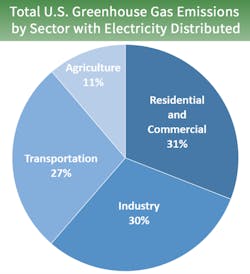Rewiring the Empire State and Beyond: Advocates make case for shift to full Home and Building Electrification
If charity begins at home (or the office), so might the most elemental part of an energy transition to decarbonizing how we live and work.
Some optimism, accompanied by a palpable sense of urgency, was plainly seen Monday morning in an online webinar panel supporting New York state’s proposed All Electric Building Act. The event was led and sponsored by non-profit advocacy group Rewiring America.
If passed into law the legislation, authored by two Democratic New York City representatives, would only allow building permits to be issued from 2024 on if the project is all electric.
This would hasten in the statewide universality of electric cold-climate heat pumps, electric stoves and all other on-site plug-in energy connections. It would mean an end to the natural gas distribution system for New York residences and businesses built after 2023.
And it might be the vanguard of a movement westward across the U.S., at least in many states.
That hard stop to fossil fuels for heating homes may seem jarringly sudden, partially unpopular and certainly logistically challenging to some, but the “Rewiring America” panelists are true believers that full electrification can and must be done.
"The technology to build now exists to make this ambitious plan a reality,” Matthew Bremer, a native Texas who is a longtime New York architect and president of the state’s American Institute of Architects chapter, said during the webinar. “All that is lacking is the willpower to get this done.”
The New York state leaders certainly may possess the focus and faith to pass the All Electric Buildings Act. The state already is committed to aggressive decarbonization measures, embracing Community Solar, Energy storage and electric vehicle adoption through a series of carrots and sticks, or incentives and mandates.
The problem is the scope and expense of such an undertaken. The National Association of Home Builders, for instance, has studied the issue and says that full building electrification would be more costly compared to other options in cold climates such as Denver, Minneapolis and, no doubt, upstate New York.
Some western New York critics also are balking at the idea of forcing new construction to be all electric. Others are pointing out resiliency worries about fuel diversity and keeping homes safe through the power grid do down during a weather event or some other mishap on the aging transmission and distribution systems.
And, little surprise, the American Gas Association has challenged Rewiring America and other current research and negative warnings about the health safety of natural gas-fired stoves, for instance.
Monday’s panelists rallied to the cause.
“There’s lot of misinformation out there,” Michael Hernandez, New York policy director for Rewiring America, countered, pointing out several corroborated research data saying building energy use contributes to about a third of greenhouse gas emissions, or even as much as 40 percent.
“Buildings alone are the largest source of emissions in the state,” he added. “We can’t get there (to net zero goals) unless we electrify housing.”
The net benefit of full building electrification, Hernandez said, is both a cleaner environment and lower financial burdens, despite some who say otherwise. Electrification ultimately will save money on home comfort bills the same way that electric vehicle charging is cheaper per mile equivalent than gas-powered cars.
The debate will rage on these issues for years to come, but the movement toward building electrification is not isolated to New York although that’s the biggest market engaged.
Earlier this month Boston Mayor Michelle Wu filed an ordinance with the city’s council that would require new buildings which rely on fossil fuels to install solar panels. Those facilities also would need to add wiring in case they chose, or were forced, to convert to electrification in the future.
Another major city tackling the front line of building electrification is Denver. Last fall heat pump systems firm BlocPower announced a collaboration with non-profit Energy Outreach Colorado and the city and county of Denver’s Office of Climate Action, to expand equitable building electrification efforts as part of the Healthy Homes Program there.
Related stories
Department of Energy's Cold-Climate Heat Pump Challenge
Global Construction Leaders commit to Decarbonization of Facilities
City of San Francisco contracting to Electrify Buildings
Subscribe to our free, tri-weekly Email newsletter
And, of course, the city of New York is chalk full of new building projects focused on decarbonization and energy efficiency. The passive building boom is under way focused on state-of-art window sealing, lighting, wall insulation and, of course, electrification, solar and even geothermal and carbon capture in some cases.
It’s all hands on deck and all new technologies needed, panelists said. Those missions include grid modernization to advanced workforce training and making a public case favoring long-term financial savings, they added.
“Architects need to come together to understand how to deliver more efficient, electric buildings the second half of this decade,” Bremer said.
The engineers, electricians and installers also need an education, the group added. Some industry firms, such as HVAC giants such as Lennox and others, already are making inroads into developing high-level and purely electric cold climate heat pumps.
The workforce transition is already under way, Hernandez replied.
“It’s the issue and micro and macro,” he said. “Our building codes are tightening up and requiring that.
New York architect John Woefling agreed.
“It’s happening already,” he said. “The familiarity with heat pump systems is becoming commonplace (at least in New York). I think more work needs to be done on that, but the marketplace will take care of that itself.”
Rewiring America is a nationwide non-profit promoting the full electrification of the building sector, from residential to commercial and industrial. Among its founders are Executive Chair Alex Laskey, who also founded energy software startup Opower which was eventually acquired by Oracle.
The organization’s senior counsel is former Georgia state representative and Democratic gubernatorial candidate Stacey Abrams.
-- -- --
(Rod Walton, senior editor for EnergyTech, is a 15-year veteran of covering the energy industry both as a newspaper and trade journalist. He can be reached at [email protected]).
Follow us on Twitter @EnergyTechNews_ and @rodwaltonelp and on LinkedIn






